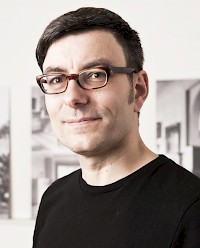Vita
Volker Pantenburg is professor for Film Studies at Freie Universität Berlin. From 2010 to 2013, he directed the PhD program “Theory and History of Cinematographic Objects” as one of the junior directors at the IKKM. Until 2016, he was junior professor for Image Theory at Bauhaus University Weimar. Between 2007 and 2010 he worked in a project on the migration of images between cinema and contemporary arts in the framework of the Collaborative Research Center "Aesthetic Experience" at FU Berlin. In 2008 and 2009 he also conceived the independent research project “Kunst der Vermittlung. Aus den Archiven des Filmvermittelnden Films.” In 2015, he co-founded the “Harun Farocki Institut,” a non-profit organisation designed as a platform for researching Farocki’s visual and discursive practice and supporting new projects that engage with the past, present and the future of image cultures. Pantenburg has published widely on essayistic film and video practices, experimental cinema, and contemporary moving image installations.
Dated from 2017
Fields of research
Migrational Aesthetics: Cinema and Museum
Cinematographic Objects
Archival Practices
Harun Farocki
Videographic Film Studies
Experimental Cinema
IKKM Research Project
Projection/Performance
Since at least ten years, analog film projection in white cubes belongs to our experience of solo and group shows, biennials and art fairs. Now that the combination of film strip and projector is no longer part of the regular cinema experience, film projection has taken refuge in the museological realm of Cinémathèques and the laboratories of artistic practice. Rosa Barba, Matthew Buckingham, Tacita Dean or Bradley Eros are amongst the many filmmaker/artists that engage in scrutinizing the possibilities and ironies of working with analog film. In my project, I plan to investigate analog film projection as a prominent tool for thinking about the materiality and historicity of the cinema experience. What does it mean to insist on a 19th century mode of showing that combines mechanical, chemical and optical elements to form a specific “working system”? Is it part of “the nostalgic veneration of cinema as a lost object now incessantly remade and recycled” (Erika Balsom), or is something else, more productive at stake? To approach these questions, I will focus on the work of Sandra Gibson and Luis Recoder, artist/filmmakers from New York who address the projector and projection in various ways.
Two hypotheses will guide me:
(1) The projector is a crucial, albeit often neglected relay in the continuum between production and reception. Mistaking it for a purely reproductive device since it primarily shows and reproduces what has previously been recorded, developed and distributed, underestimates what is happening in this categorical shift from the material to the projected image. By emphasizing the projector as an instrument and the projection booth as a location usually hidden from the eyes and ears of the audience, Gibson/Recoder ironically invert the hierarchies of showing and consider projection as production.
(2) Works like Gibson and Recoder’s act like a prism to address the peculiar object character of the medium film. Contrary to traditional notions of painting and sculpture, the materiality of film is dislocated and dissociated, since it oscillates between the film strip, the projector and the projected image. In doing so, they return to an earlier moment in the history of experimental cinema, the late 1960s, when filmmakers like Hollis Frampton approached the question of media specificity from the vantage point of objecthood and suggested to think of film as a “pattern of energy.” Considering the nexus between projection and objecthood will allow me, I hope, to continue the research I started at the IKKM between 2010 and 2013 in the framework of the PhD program on “Cinematographic Objects.”
Recent publications
Selected Monographs and edited volumes
Farocki/Godard. Film as Theory, translated by Michael Turnbull, Amsterdam: Amsterdam University Press 2015.
Kino-Enthusiasmus. Die Schenkung Heimo Bachstein, Weimar: Lucia Verlag 2016 (with Katrin Richter).
Cinematographic Objects. Things and Operations, ed. Volker Pantenburg Berlin: August 2015.
Wörterbuch kinematografischer Objekte, Berlin: August 2014 (with Marius Böttcher, Dennis Göttel, Friederike Horstmann, Jan Philip Müller, Linda Waack and Regina Wuzella).
Screen Dynamics. Mapping the Borders of Cinema, Vienna: Filmmuseum/Synema 2012 (with Gertrud Koch und Simon Rothöhler).
Recent Articles in English
The Third Avantgarde. Laura Mulvey, Peter Wollen, and the Theory-Film, in: Beyond the Scorched Earth of Counter-Cinema. The Films of Laura Mulvey and Peter Wollen, ed. by Oliver Fuke, Laura Mulvey and Sukdhev Sandhu, New York: texte und töne 2016, S. 32-41.
Studies in Blurring. Matthias Müller: While You Were Out, in: Camera Austria 136/2016, S. 33-40.
‘Now that’s Brecht at last!’ Harun Farocki’s Observational Films, in: Erika Balsom / Hila Peleg (ed.): Documentary across Disciplines, Cambridge: MIT Press 2016, S. 102-121.
Videographic Film Studies and the Analysis of Camera Movement, in: NECSUS. European Journal of Media Studies, Spring 2016.
Working Images. Harun Farocki and the Operational Image, in: Jens Eder / Charlotte Klonk (ed.).: Image Operations. Visual Media and Political Conflict, Manchester: Manchester University Press 2017, S. 49-62.
Situations, Infrastructures, Temporalities. Emanuel Licha’s Hotel Machine, in: Emanuel Licha: Et maintenant regardez cette machine, Montréal: Musée d’Art Contemporain 2017, S. 43-61. (engl./frz.)
